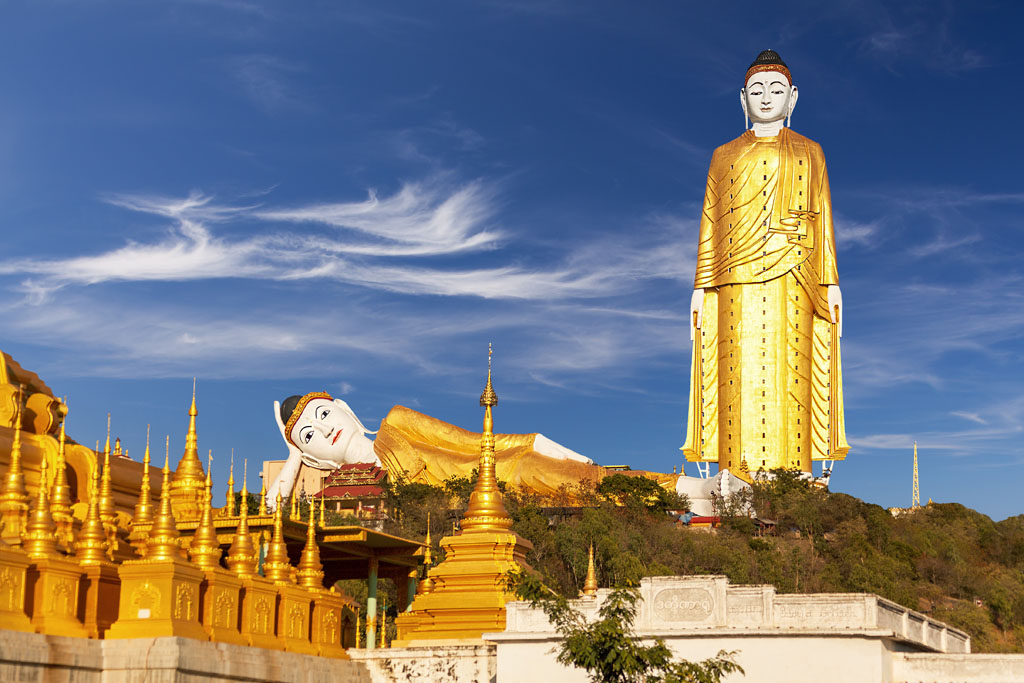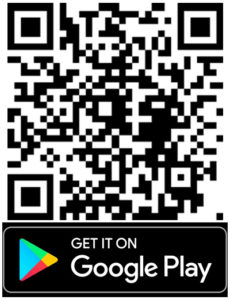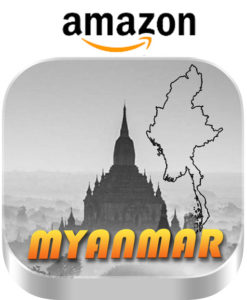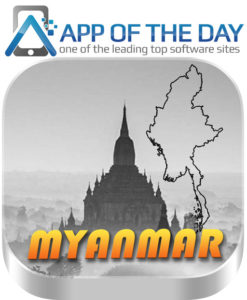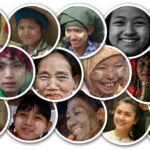Buddhist Symbols
Votive tablets
They are flat-backed clay, sandstone or soapstone tablets with images in low relief on the front within a thick rim The bottom is usually squared and the top is arched to a point. Sometimes there are incised lines on the bottom or at the back. There were tens of thousands made in ancient times and enshrined in pagodas, not only in Myanma but in all countries of Asia where Buddhism once flourished or still flourishes.
 The most popular design of votive tablets contains the eight great events from Buddha Gautama’s life:
The most popular design of votive tablets contains the eight great events from Buddha Gautama’s life:
1. Nativity, the mother Queen Maya standing upright and with one arm around the shoulders of her sister and the other holding a branch of the Ingyin tree (Pantacme suavis)
2. Enlightenment, of a larger image of the Buddha, set in the middle in a meditative or earth-touching pose.
3. The first sermon preached to five hermits in the deer park
4. Twin miracles of fire and water flowing from Buddha’s body
5. Descent from heaven where Buddha spent the three months of Lent preaching to the celestial who in the previous life was theBuddha’s mother Queen Maya
6. Taming the Nalagirin Elephant which had been sent by an evil monk to kill the Buddha
7. Lady Sujita offering milk gruel
8. Buddha’s death scene.
Sometimes the offering of milk gruel is replaced by the monkey offering a honeycomb or it might also be included to make nine scenes.
Footprints
 Buddha on his deathbed has forbidden his followers to make images in his likeness for he wanted his teachings to remain purely focused on the Buddhist texts. Only 500 years after his passing were his images first made. Previously, the footprint was one of the few symbols used as a representation. The stylized design of the Buddha’s footprints, with 180 symbols on each sole, is a sacred motif.
Buddha on his deathbed has forbidden his followers to make images in his likeness for he wanted his teachings to remain purely focused on the Buddhist texts. Only 500 years after his passing were his images first made. Previously, the footprint was one of the few symbols used as a representation. The stylized design of the Buddha’s footprints, with 180 symbols on each sole, is a sacred motif.
On the pads of the toes are conch shells symbols. On the soles are spears, flowers, birds, white umbrellas, crown, peacock feather, water pot, golden fish, palaces, banners, plus noble animals such as elephants, lions, and tigers.
Iconography
28 Buddhas
It is part of Buddhist lore that altogether 28 Buddhas have graced the earth and each had attained enlightenment under the Bodhi tree (Ficus rekigiosa). Hence this tree is often seen on pagoda platforms
Seated images
In all seated images the legs are crossed with both soles turned upwards. Images seated as if on a chair are very rare and mostly seen in the southern part of Myanmar. This symbolizes the time that Buddha soon after his enlightenment went to see his father the king at the palace, where he sat on a chair. Princess Yahawdaya, his wife in his previous secular life, cried bitterly, rubbing her face on his feet.
Standing images
They are of four types:
1. Feet together, the body held rigidly, and the robes hanging straight down means the Buddha is standing still the hand is likely in the Abhaya Mudra, protecting or Mahakarunika Mudra showing compassion.
2. Feet slightly apart and the body less rigid means the Buddha is walking, but this is a casual pose that is not often seen.
3. Feet together and fingertips lightly touching the robes on either side of the body and the bottom of the robes flaring widely means the Buddha is flying in the air. With this image, there is very likely a line of standing monks behind.
4. The Buddha and a line of monks after hum all holding alms bowls, symbolizing the morning food around.
Crowned images
The image wears a bejeweled crown on the head and ornate regalia on the shoulders, plus armbands and bracelets. It is believed to symbolize the time that the Buddha emphasized the impermanence of material things to a boastful king named Jumbudarit by creating himself dressed in magnificent regalia and then making the costume disappear in an instant. This image is thus known as the ‘Jumbudarit’ style. Another view by scholars is that it represents Mettreya, the Future Buddha.
Reclining Images
There are of two types: the Buddha at rest, lying on his right side with the right hand propping up his head. The left-hand lies along his body and the left knee are slightly bent so that the feet are not aligned. The eyes are open.
The Parrinirvana or dying has the body lying on its right side body with the head on the pillow. The right arm is folded under the cheek. The body and feet are straight, with the soles of the feet placed one on top of the other. The eyes are closed or downcast.
Hand Positions
The different hand positions of Buddha images are called ‘mudrag’ and not used for anyone else, king, spirit or celestial.
1. Dhyana Mudra, meditating. Seated image, hands together on the lap.
2. Bhumispasa Mudra, swearing by the earth. Seated image, the right fingertips touch the earth.
3. Dharmacakra Mudra, preaching. Seated image, both hands are raised.
4. Vitarka Mudra, discoursing. Seated image, both hands are raised
5.Abhaya Mudra, giving protection. Usually standing, both hands are raised, palms outwards.
6. Mahakarunika Mudra, showing compassion. The hands are held on the heart.
7.Bithetkaguru Mudra, healing. Seated image, the right-hand finger: hold a small medicinal fruit; a pot of water is placed on the lap or the upturned left palm.
8.Varadha Mudra, giving. The right hand is held down, pain outwards….

